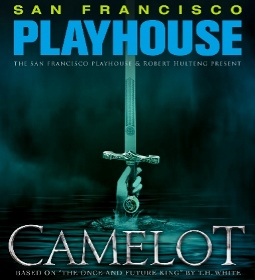IT’S TIME FOR A LITTLE HAPPY EVER-AFTERING
As San Francisco Playhouse opens a promising and highly anticipated rendition of Camelot this week, I am reminded of T. H. White’s The Once and Future King, the source material of the musical, and its effect on me when first I read it. But I am also reminded of Camelot’s turbulent history and why the show is so tough to stage well.
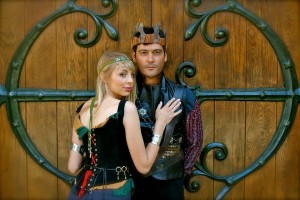 The musical endures with the public not because it was a perfect creation, but because of its close association with JFK, who used to listen to the album, particularly the title song, before he went to bed, a fact revealed by his widow just after the assassination. But on stage, the show has been troubled by a ponderous libretto. Indeed, the original Broadway outing was hampered not just by its book, but the pomposity of the design. A recent revival at Pasadena Playhouse did a fine job reinventing the show, but threw out the character of Merlin entirely, and still had trouble getting to the heart of the musical. All other revivals were so overblown and miscast, that they verged on dull, including the production with Michael York and another with Robert Goulet as Arthur.
The musical endures with the public not because it was a perfect creation, but because of its close association with JFK, who used to listen to the album, particularly the title song, before he went to bed, a fact revealed by his widow just after the assassination. But on stage, the show has been troubled by a ponderous libretto. Indeed, the original Broadway outing was hampered not just by its book, but the pomposity of the design. A recent revival at Pasadena Playhouse did a fine job reinventing the show, but threw out the character of Merlin entirely, and still had trouble getting to the heart of the musical. All other revivals were so overblown and miscast, that they verged on dull, including the production with Michael York and another with Robert Goulet as Arthur.
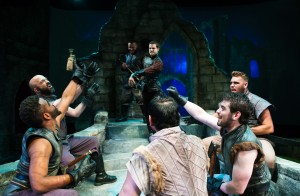 This is why I’m thrilled that director Bill English and his team are scaling back Camelot, substituting Knights in Shining Armor for medieval “bikers with clubs.” Arthur is a now a “dreamer with a crazy idea,” Guenevere an “angry Goth princess,” Mordred a “budding Richard III,” and Lancelot “a religious zealot unaware of his sexual nature” (note that this production is recommended for viewers age 10 and up). Nina Ball’s medieval fantasy set designs will be a blend of Camelot and Game of Thrones. One of the most exciting changes is that battles which were written to be off stage will now occur on stage — expect some exciting fight choreography. Based on English’s scaled-down and incredibly charming version of last summer’s SF Playhouse hit, My Fair Lady, I and other friends are making the journey from Los Angeles specifically to see Camelot.
This is why I’m thrilled that director Bill English and his team are scaling back Camelot, substituting Knights in Shining Armor for medieval “bikers with clubs.” Arthur is a now a “dreamer with a crazy idea,” Guenevere an “angry Goth princess,” Mordred a “budding Richard III,” and Lancelot “a religious zealot unaware of his sexual nature” (note that this production is recommended for viewers age 10 and up). Nina Ball’s medieval fantasy set designs will be a blend of Camelot and Game of Thrones. One of the most exciting changes is that battles which were written to be off stage will now occur on stage — expect some exciting fight choreography. Based on English’s scaled-down and incredibly charming version of last summer’s SF Playhouse hit, My Fair Lady, I and other friends are making the journey from Los Angeles specifically to see Camelot.
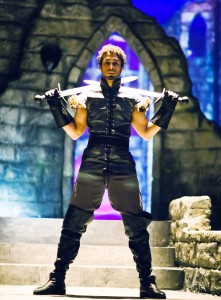 Wilson Jermaine Heredia, who won a Tony Award for his performance as Angel in the original Rent, will play Lancelot. Also featured are Johnny Moreno (Arthur), Monique Hafen (Guenevere) and Charles Dean (Merlin & Pellinore); all three are winners of San Francisco Bay Area Theatre Critics Circle Awards for Best Actors in a Musical for My Fair Lady.
Wilson Jermaine Heredia, who won a Tony Award for his performance as Angel in the original Rent, will play Lancelot. Also featured are Johnny Moreno (Arthur), Monique Hafen (Guenevere) and Charles Dean (Merlin & Pellinore); all three are winners of San Francisco Bay Area Theatre Critics Circle Awards for Best Actors in a Musical for My Fair Lady.
One of the defining moments of my adolescence came immediately after finishing The Once and Future King, White’s fantastical retelling of the Arthurian legend. Part one, The Sword in the Stone, tells of the young squire Wart (Arthur), who is educated by the prognosticating wizard, Merlin. To teach him the ways of the world and what it means to be a good king, the boy is transmogrified by Merlin into all sorts of fauna. This light-hearted section of the book was adapted into Disney’s film of the same name.
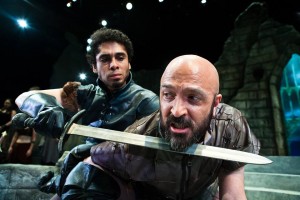 Part two, The Queen of Air and Darkness, introduces us to incidents which will lead to the King’s downfall. The final two parts, The Ill-Made Knight and The Candle in the Wind, tell us of Sir Lancelot and Queen Guenevere’s forbidden love, and Arthur’s demise at the hands of Mordred, his illegitimate son by his half-sister Morgause (the musical was mostly adapted from parts III and IV). The last part of the book, more meditative and serious in tone, wrecked me. Arthur, who had fought for “Right over Might” with his Knights of the Round Table, finds that he has been blinded by his idealism. The King was taught by Merlin that war is justifiable to prevent a greater evil, but doesn’t that mean we will always be at war? In the final pages of the novel, the dying king bestows knighthood on a lad who promises to keep Arthur’s candle of ideals from burning out. As I closed the book, I had never before, nor have I since, felt so despondent, hopeful, depressed and exhilarated at the same time.
Part two, The Queen of Air and Darkness, introduces us to incidents which will lead to the King’s downfall. The final two parts, The Ill-Made Knight and The Candle in the Wind, tell us of Sir Lancelot and Queen Guenevere’s forbidden love, and Arthur’s demise at the hands of Mordred, his illegitimate son by his half-sister Morgause (the musical was mostly adapted from parts III and IV). The last part of the book, more meditative and serious in tone, wrecked me. Arthur, who had fought for “Right over Might” with his Knights of the Round Table, finds that he has been blinded by his idealism. The King was taught by Merlin that war is justifiable to prevent a greater evil, but doesn’t that mean we will always be at war? In the final pages of the novel, the dying king bestows knighthood on a lad who promises to keep Arthur’s candle of ideals from burning out. As I closed the book, I had never before, nor have I since, felt so despondent, hopeful, depressed and exhilarated at the same time.
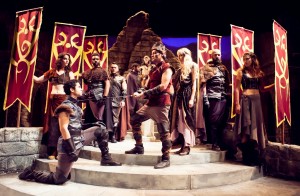 Coincidentally, those same adjectives describe the critics’ mixed reviews for Camelot when the 1960 musical opened two years after the book’s publication. The anecdotes of Camelot’s pre-production fiascos are legendary, starting with the trifecta responsible for My Fair Lady (1956): Director Moss Hart suffered two heart attacks, dying one year after the premiere; librettist and lyricist Alan Jay Lerner was hospitalized for bleeding ulcers; and composer Frederick Loewe, who had collaborated with Lerner for decades (Brigadoon (1947), Paint Your Wagon (1951), Gigi (1958)), simply walked away from his partner and retired from Broadway forever.
Coincidentally, those same adjectives describe the critics’ mixed reviews for Camelot when the 1960 musical opened two years after the book’s publication. The anecdotes of Camelot’s pre-production fiascos are legendary, starting with the trifecta responsible for My Fair Lady (1956): Director Moss Hart suffered two heart attacks, dying one year after the premiere; librettist and lyricist Alan Jay Lerner was hospitalized for bleeding ulcers; and composer Frederick Loewe, who had collaborated with Lerner for decades (Brigadoon (1947), Paint Your Wagon (1951), Gigi (1958)), simply walked away from his partner and retired from Broadway forever.
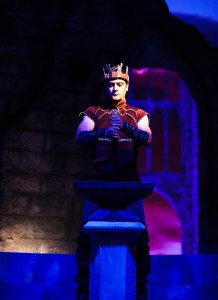 What happened to these geniuses of the theater? They became as blinded by their ideals as King Arthur. The mostly gorgeous score, which includes “If Ever I Would Leave You” and “How to Handle a Woman,” was weighed down by a ponderous and talky libretto which, along with the direction, refused to settle on a consistent tone. The team went for pageantry and spectacle instead of honing in on the central relationships, which lacked depth and wit. The technical gestures bestowed on the production were so overblown, costing $500,000 in 1960, that the show was dubbed “Costalot.” Every penny could be seen in the set by Oliver Smith and the costumes by Tony Duquette. Critic John McClain noted that the combination of these designers produced a series of tableaux which for color and conception could chase many an old master off the walls of our museums. Adrian, the MGM costume designer responsible for The Wizard of Oz – and husband to Janet Gaynor for 20 years even though he was openly gay – came out of retirement to costume Camelot, for which he received co-credit, but he suddenly died at the age of 56 in 1959.
What happened to these geniuses of the theater? They became as blinded by their ideals as King Arthur. The mostly gorgeous score, which includes “If Ever I Would Leave You” and “How to Handle a Woman,” was weighed down by a ponderous and talky libretto which, along with the direction, refused to settle on a consistent tone. The team went for pageantry and spectacle instead of honing in on the central relationships, which lacked depth and wit. The technical gestures bestowed on the production were so overblown, costing $500,000 in 1960, that the show was dubbed “Costalot.” Every penny could be seen in the set by Oliver Smith and the costumes by Tony Duquette. Critic John McClain noted that the combination of these designers produced a series of tableaux which for color and conception could chase many an old master off the walls of our museums. Adrian, the MGM costume designer responsible for The Wizard of Oz – and husband to Janet Gaynor for 20 years even though he was openly gay – came out of retirement to costume Camelot, for which he received co-credit, but he suddenly died at the age of 56 in 1959.
Perhaps the show was cursed because Americans, high on winning WWII and turning into voracious consumers, had to make everything bigger and better, going for style over substance, ruining the Camelot we were trying to create. I still believe in that ideal of a utopian Camelot – especially “Right over Might” – as much as I believe that Camelot the musical can work. And I believe that Mr. English is up to the task.
production photos by Jessica Palopoli
Camelot
San Francisco Playhouse
scheduled to end on September 14, 2013
for tickets, call 415-677-9596 or visit http://www.sfplayhouse.org
